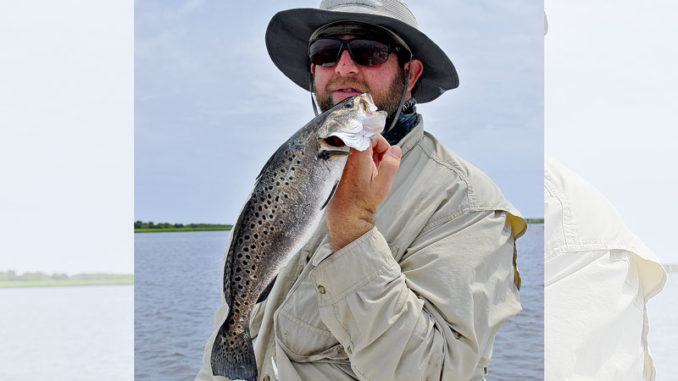
Changing weather patterns and water conditions put speckled trout in a rush to change locations in Louisiana’s coastal marshes in May. Here’s why they move and how to follow them.
It’s May, and anglers on the Gulf Coast are lathering on the sunscreen and trying to repeat their April success with limits of speckled trout. But the conditions this month are different from the adjacent months in a few significant ways, including weather patterns, water temperature and water quality. To effectively find and catch speckled trout, it helps to understand how these unique characteristics impact them.
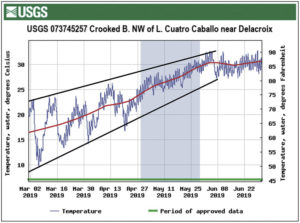
Temperature changes
The winter and early spring weather patterns of cold fronts have changed to frequent warm winds off the Gulf of Mexico. Water temperature reflects this change in weather patterns, and to show this, I pulled 2019 data from the USGS station at Crooked Bayou near Four Horse Lake, southeast of Delacroix. I chose this station because it is not directly affected by Mississippi River water. The chart clearly shows that the cold front-driven water temperature swings in March and April have reverted to a tight range of less than 10 degrees in May. Also visible are moderate water temperatures that averaged 75 degrees in early May to 85 degrees by the end of the month.
The air temperature may start to feel a bit hot, but the water temperature range is downright balmy for speckled trout. In this tight temperature range, their metabolism is steady, and they can move through any water depth without their metabolism spiking high or low. I imagine that May is a time of true freedom for trout, when they can crash bait wherever it exists and swim into any inshore body of water they desire.
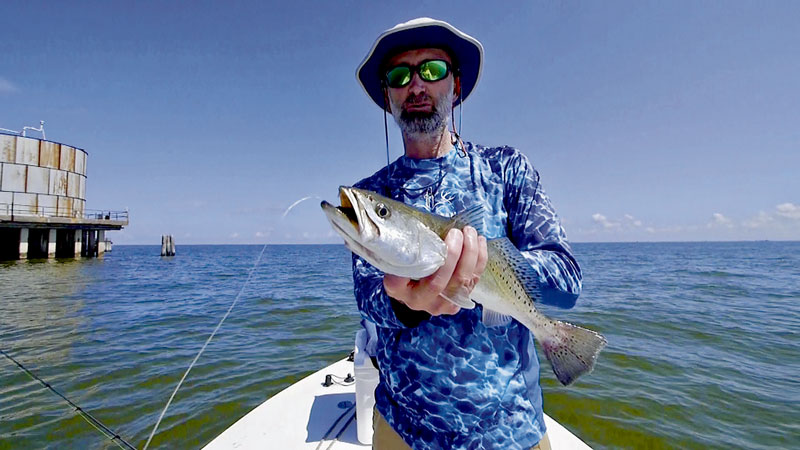
Water quality changes
May is a transition month for water quality. In years without extreme Mississippi River heights, the water quality will improve for speckled trout as turbidity decreases and salinity increases. The turbidity will decrease as strong north and west winds cease and the southeast wind brings in clean water from the Gulf. Salinity is, of course, very dependent on the amount of freshwater poured into the inshore waters by the rivers, and that can vary widely in March, April and May. However, as the influx slows and steady southeast winds increase, the salinity will begin to trend upward.
In early May, high salinity is not a need for most speckled trout, because while their eggs are beginning to grow, they will not need the 15 ppt or higher salinity water to spawn until the end of May. Speckled trout are a euryhaline species, which means they are capable of regulating their electrolyte levels in water from nearly fresh to full sea water. However, it appears that as they age, they prefer higher salinity, so it’s my assumption that higher salinity is a more-comfortable condition for speckled trout. For all these water quality related reasons, May is surely one of the most comfortable months of the year for speckled trout.
Diet
In the winter and early spring, a speckled trout’s diet primarily consists of finfish such as croaker, mullet, killifish, sheepshead minnows and silverside minnows. However, brown shrimp have been growing in the marsh over the winter, and they begin to move out of their shallow environments into lakes in April. By May, these crustaceans have grown and are moving from the lakes into the sounds. When this happens, brown shrimp become the most plentiful food in the estuary for speckled trout. In addition to their numbers, biologists tell us that shrimp provide nutrients helpful for egg production in trout, and indeed, small to medium-sized trout seem to prefer a diet of shrimp during the prespawn period. Shrimp also create a moving food source on which the speckled trout can gorge themselves, while moving to the outside waters in preparation for the summer spawning season.
Where to find trout in May
In general terms, speckled trout will be targeting migrating brown shrimp in May. These masses of shrimp can be found from the large, inner lakes out into the sounds. Shrimp travel long distances during the spring by riding on tidal waters. They live on the bottom, but when a strong outgoing tide moves, they will suspend in the water column and be swept along with the tide. Therefore in May, speckled trout will typically be feeding on shrimp when there is moving water. A favorable feeding spot for trout is near a pinch point in tidal water flow. In these places, the moving shrimp will become concentrated and easier for trout to catch.
Brown shrimp
In May, large numbers of brown shrimp are in large lakes, feeding on plankton and detritus on the bottom. They are not helpless from attack by predators due to their iconic tail snap, so shoals of trout will drive them off the bottom to gain an advantage over them. This feeding technique exposes the presence of trout to anglers when snapping shrimp break the water surface, and flocks of seagulls dive on the shrimp. Anglers should be on the lookout for both these signs of shrimp to find concentrations of speckled trout in May.
Unfortunately, in some areas, the shoals of trout found under diving seagulls will be juveniles, with only a few keepers. A good strategy for fishing under diving birds is to cast a few times under the birds with a swimbait either tight-lined or under a cork. If several juvenile trout are caught, there is a high possibility that very few keepers exist in the shoal, and it’s better to move on. It’s also possible that diving birds will reveal gafftopsail catfish feeding on the shrimp and not speckled trout, which may be a disappointment or windfall depending on your level of desperation.
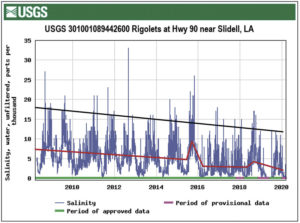
Lake Pontchartrain
The salinity in Lake Pontchartrain is too low for speckled trout to spawn, but they can be found there for as many as nine months out of the year. In decades past, the salinity in the lake was higher due to seawater intrusion into the lake via the Mississippi River Gulf Outlet (MRGO). An earthen and rock barrier was built across the MRGO near Hopedale Marina in 2009, and in 2011, a flood protection wall was built across the MRGO near Chalmette. The combination of these structures has nearly cutoff seawater intrusion into the lake and returned salinity concentrations to those seen in 1960 before the MRGO was built.
A chart shows the salinity decrease from 2008, before the MRGO barrier was constructed, to present day. The decrease is evident in the mean salinity and maximum salinity measured at the Hwy 90 USGS station.
In 2020, very few adult speckled trout will be found in the lake from mid-June until mid-September due to a salinity concentration below the speckled trout’s estimated spawning requirement, which is a minimum of 15 ppt.
Fortunately for local anglers, many speckled trout will not spawn until June and will be found in abundance in Lake Pontchartrain, especially during early May. Telemetry studies conducted by LSU researchers in 2013 and 2014 found that speckled trout were prevalent in May on the eastern end of the lake. These areas include the northeast and southeast shoreline and around the three bridges on the east end of the lake.
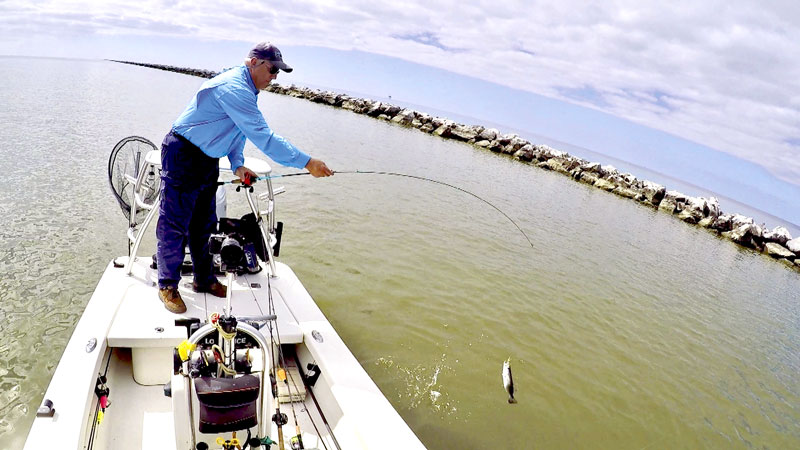
The MRGO South
As mentioned above, a barrier — locally called the MRGO Dam — was constructed across the MRGO channel in 2009 to reduce marsh erosion and saltwater intrusion into the Lake Pontchartrain Basin. Downstream from the barrier to Breton Sound is the MRGO South. This barrier, near Hopedale Marina, is somewhat porous and allows tidal water to flow through in both directions. This tidal flow and the rock structure has created an excellent habitat for speckled trout from late fall to early spring.
By May, many trout can be found in the MRGO South from approximately the midway point to the end of the rocks in Breton Sound, a 15-mile section. The lower section has 8 miles of rock jetty on the west side of the channel, called the Long Rocks, and 3 miles of rock jetty on the east side, called the Short Rocks. These rock jetties are among the most-productive trout fishing features on the east side of the Mississippi River in May. The bays and marsh edges to the east of the MRGO South jetties are also excellent May fishing locations. For instance, Eloi Bay has good fishing around its many oil and gas rigs and along Deadman Island.
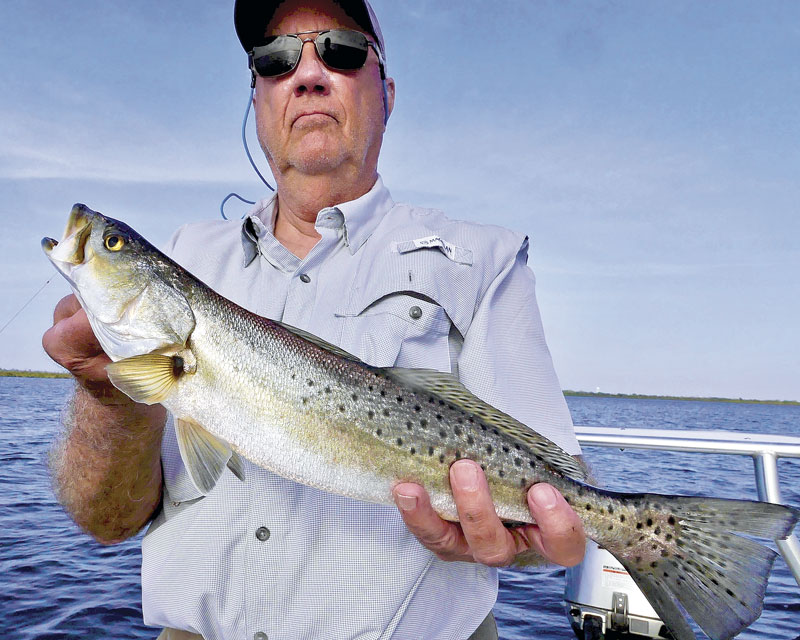
The Barrier Islands
About 150 miles of the Louisiana coastline is spattered with barrier islands. Many islands on this stretch of coast have been severely eroded or lost completely to hurricanes and habitat destruction, but many still exist and provide excellent fishing habitat. The CPRA (Coastal Protection and Restoration Authority) 2017 Master Plan for the Louisiana coast has budgeted $1.5 billion for barrier island and headland restoration. This work is defined as the creation and restoration of dune, beach and back barrier marsh with the goal of restoring or augmenting offshore barrier islands and headlands. A recent project completion under this program was Queen Bess Island on the edge of Barataria Bay.
May is an excellent time to fish on the barrier islands, especially the remote islands, which require lengthy, open-water crossings. March and April are prone to strong fronts causing high north wind and rough seas, and June begins the summer period when violent afternoon thunderstorms can cause hazardous seas. In May, speckled trout begin to show up around the islands, and the less-turbulent weather makes for safer travel to the islands.
Many different habitats exist across this swath of islands, providing memorable fishing experiences, such as surf-fishing on Elmer’s Island or wade-fishing the grass flats along the Chandeleur Islands chain. The most-accessible areas are Grand Isle and its nearby islands. Grand Isle is the only barrier island accessible by road; it has launching points from which surrounding islands can easily be reached by boat. Other launching points for boat access to barrier islands include Venice, Port Sulfur, Hopedale, Leeville and Cocodrie. The Chandeleur Islands are typically reached by seaplane from New Orleans or by boat from the Mississippi coast.
May tactics for specks
My selection of baits for May is based on two primary factors: trout’s metabolism and diet. Water temperature drives metabolism in fish, with higher temperatures increasing metabolism. Increasing metabolism causes an increase in respiration and energy consumption. This drives fish to consume more food, up to the point where the temperature becomes too high and a state of shock ensues, which leads to the death of the fish. In most circumstances, the fish retreat to cooler water and slow their metabolism instead of going into shock.
Fortunately, the water temperatures in May are perfect for moderate metabolism in speckled trout, and they will remain active and feed aggressively throughout the month. Therefore, I will be using baits that have a moderate to fast presentation and produce a good amount of noise. These include jerkbaits, fast-twitch baits, aggressively jigged swimbaits and popping corks.
The second factor is diet, and as stated above, the majority of speckled trout in Louisiana will feed primarily on brown shrimp. Second, they will feed on finfish species that are present,such as mullet, menhaden and bay anchovies. Therefore, shrimp imitation swimbaits or shrimp-colored swimbaits are a good choice for May, and of course, live shrimp will be very effective.


